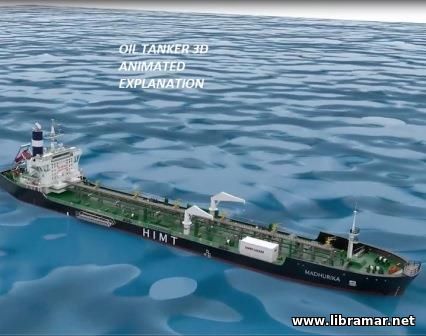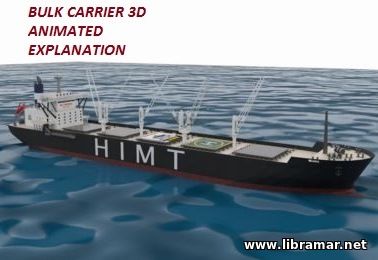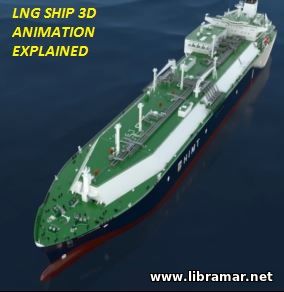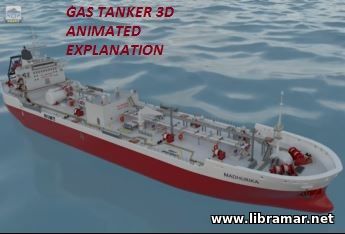 This fifth animation of the 3D series is dealing with the oil tankers and covers the essential items and equipment typical for these ships. Traditionally for these animations, the video takes us to the forecastle deck of the vessel, showing the location of the mooring equipment, such as the windlasses and towing arrangements, then the forward mast and the fire monitor intended to fight the fire in that area.
After that, the tour proceeds with the ballast tank manhole doors, cargo tank domes, cargo handling equipment, emergency stop arrangements. The cargo equipment is covered in detail, including the manifolds, valves, and deck seal. On the aft part of the vessel you will see the mooring winches and the free-fall lifeboats commonly installed on the modern oil tankers, aft towing arrangement etc.
The accommodation deck and navigating bridge deck are shown, as well. Among the other shipboard equipment shown there are lifesaving appliances, firefighting equipment and systems, and so many others, giving the trainee more or less full picture of what can be expected in the real life.Note that there are other videos available, covering the container vessels, bulk carriers, gas carriers, and LNG carriers.
 This animation shows the important items and parts of the container vessel. Having started with the mooring equipment of the vessel, such as the mooring lines used to tie and secure the ship to the berth, and rat guards used to prevent the entry of rats and other rodents to the vessel, mooring winches, we move to the items specific to this vessel type, such as the electrical power sockets for the reefer containers.
After that, the authors of the animation decided to demonstrate the twist locks that are commonly used to secure the containers to the deck or hatch covers and interlock them vertically between tiers, as well as the lashing equipment used to secure the containers while stacking. Noe that this particular animation shows the vessel in port, that is why the quay container handling equipment, such as the gantry crane, has also been paid attention and the typical cargo discharge operation has been shown.
The main types of containers have been demonstrated together with the applicable markings and their locations. This is a truly nice resource for studying the basic parts of the container carrier. Note that there are other videos available, covering the LNG carriers, bulk carriers, oil tankers and gas tankers.
 This is a professionally prepared high-quality video animation showing and explaining the vital parts of the bulk carrier. The animation starts with the general view of the vessel and then the navigational bridge, accommodation module and superstructure, followed by the view on the forecastle deck, where the positions of the mooring equipment, including the windlass, bollards, anchor chain and mooring ropes, then bulwarks, and foremast are shown.
After that you will proceed to the anchor and accommodation ladder/gangway, hatch cover in operation, and cargo gear, including the floating block, topping lift, crane itself, and driver’s cabin. Then you will move to the stern, where the location of the engine room exhaust gas trunkings, funnel trunk, and engine room ventilation fans is shown. The aft mooring equipment including the warping drum and winch, is demonstrated, together with the free-fall lifeboat.
In short, we can say that all important parts of the vessel of this type have been covered, so this introductory video can be recommended to the people with no experience but with the interest in construction and equipment of the bulk carriers. Note that there are other videos available, devoted to the container ships, gas tankers, liquid natural gas carriers and, finally, oil tankers.
 Another animation explaining the onboard arrangement, this one dealing with the LNG, or liquid natural gas carriers. The video starts with the quick tour over the forecastle deck of the vessel, showing the location of such important items as the fairleads, rope hatch, cruciform chocks, port and starboard windlasses, deadman rollers, mooring bits.
The cargo domes and MARV, standing for the maximum allowable relief valve, are shown on the deck, followed with the vent masts and fixed DCP, or dry chemical powder extinguishing station, etc. The cargo hose handling crane is shown, as well, together with the cargo manifold, including the vapour line, liquid lines, and bunker manifold. After that the trainees with get to know the location of the deck store room and so-called SOPEP locker on board.
Among the items at the navigation bridge, the ECDIS, VHF radiocommunication equipment, AID, X-Band and S-Band radars, engine telegraph and main engine systems display, NavTex, navigational lights panel and other equipment is demonstrated. The firefighting equipment and systems are duly addressed. Note that there are other videos available, covering the container vessels, gas carriers, bulk carriers, and oil tankers.
 This animation is showing the key elements of the gas carrier. First of all, it will show you the arrangement of the forecastle deck of the ship, followed with the ballast tank hatch covers and vents, cofferdam sounding pipes, cargo manifolds and other deck items including the lifesaving appliances, such as the inflatable liferafts both with and without the HRU, standing for the hydrostatic release units, and the free-fall lifeboat installed in the aft part, and the deck firefighting station.
Talking of the cargo handling equipment, and considering the type of cargo carried on board these vessels, you will see the deck tank of IMO type C, relief valve, cargo hatch with deepwell cargo pumps. The expansion joints installed in the liquid and vapour pipelines have been shown due to their importance…
In general, this is a very good and sufficiently detailed tour on board the typical gas carrier, and it can be recommended to anyone willing to acquaint themselves with the respective arrangements – they should just spend six minutes watching this brilliant animation. Note that there are other videos available, covering the container vessels, bulk carriers, LNG carriers, and oil tankers.
 This instructional video is for those wishing to know how to make ties, knots and splices. The sailor ropes commonly get made into the different lines hoisting and controlling the ship's sails, handing fenders outboard and, in general, used for so many other things on board.
However, these lines themselves are absolutely useless unless the sailor knows how exactly to work with the lines, and in particular how to attach them properly to the other objects. And that is where the knots are coming, being highly evolved instruments putting the ship's lines to work. In the present program the author is going to demonstrate you the most popular knots that all sailors need.
The instructions contained in the video are very easy to follow owing to the professionalism of the author, his experience and approach he used when preparing the content of the film. This all has gained so much of popularity to this video which is treated as a classical video-guide to all newcomers to the maritime world. We recommend you to have a close look and guarantee that you will like the process of learning how to make ties and making them yourself following the clear instructions.
 The "Evolution of the oil industry" one of the best educational documentary films devoted to the oil exploration and production history. The video has been found very interesting by the people who watched in in different parts of the world, and particularly by those involved in oil industry; in addition, its content has been of interest for the future students of relevant specialties.
It is showing the major stages of the oil industry development. It really makes sense for any person somehow involved in the exploration and production of hydrocarbons (whether on land or offshore) to have a close look at how the industry has been developing through the years and what technological advances took place as it may help in getting to the better understanding of the technical solutions of today and their correct application. Again, the film will be interesting even to the people outside the oil industry since it is not technical at all and will therefore be understandable to everyone who watches it.
 The old film devoted to the birth and development of the oil exploration and production in Saudi Arabia. The period in question is about 1950 plus.
The content of the video was developed by the specialists of the several famous oil companies working in the subject region and reflects the results of the joint efforts of the BECHTEL Corporation, TAPLC, standing for the Trans Arabial PipeLine Co., Arabian-American Oil Co.
People who are interested in the history of the oil industry will definitely find the film interesting since it not only show the development of Saudi Arabian oilfields but also touches the important historical aspects.
|







